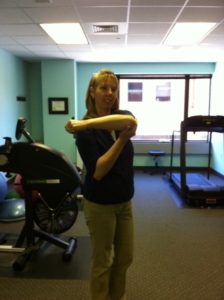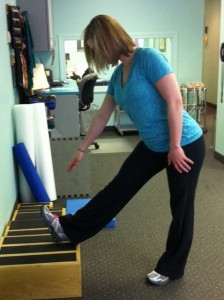Many pregnant women develop back pain. This is due to increased weight gain causing stress on the spine. By having increased stomach weight, one develops a increased lumbar curve putting strain on the back musculature. Many women find themselves seeking physical therapy to help to decrease their back discomfort. Physical Therapy consists of manual treatment to the back, heat, stretching, and core/pelvic floor exercises. If you are pregnant and experiencing back pain, please contact our facility for an appointment.
About amacht
Morton’s Neuroma
A Morton’s neuroma is a thickening of the tissue around one of the nerves leading to your toes. Most commonly it occurs between your 3rd and 4th toes. It is also most common in middle aged women and early intervention is important.
Symptoms of a Morton’s neuroma include, tingling, numbness, burning, or pain at the ball of the foot. A common report is symptoms mimicking something stuck to the bottom of your foot.
One of the most common causes is improper footwear. Wearing shoes without much support like flip flops, high heels, and flats can cause a compression and irritation of the nerve. Other causes are previous foot problems and repetitive damage from sports.
Early treatment should include ice and changing footwear. If symptoms persist, consult with your local physical therapist. Physical Therapy would include massage to the foot, stretching, and exercises. This works to help to decrease inflammation and increase blood flow to promote healing. A physical therapist can also educate you on proper foot wear and orthotics. Injections may be needed to help decrease the inflammation. If conservative measures are not successful, surgery is performed to release pressure on the nerve.
“No Pain, No Gain” Theory
When working out, it is normal to feel fatigue and muscle burn with strength/endurance training. But you should be aware of the difference between muscle fatigue versus pain. If you experience pain while working out, you should stop the activity you are doing. Pain can develop from inflammation, bad form with exercise, and overuse of a specific muscle. Pushing yourself too far could lead to an injury that can prevent you from doing the sports or exercises you enjoy. Use ice to decrease the pain developed from the exercise. If your symptoms do not lessen with ice and rest, visit your local physician or physical therapist.
X-ray vs. MRI
An x-ray determines the alignment and condition of your bones. Examples of things x-rays can display are deformities of the spine, fractures, bone spurs, tumors, spaces between the discs of the spine, and infections.
MRI stands for magnetic resonance imaging. MRI’s will determine the condition of your muscles/ligaments and the discs in your spine. Your doctor may not order an MRI initially. Typically no matter what is displayed on the MRI, a physician would recommend physical therapy as the first form of conservative treatment. An MRI will help the doctor determine if surgery is required for your injury.
Food Safety in the Summer
Food can spoil easily on hot summer days; follow these tips to prevent spoiling your fun with food borne illness.
- Plan picnics to include foods that don’t require refrigeration: fruit salad vs. pasta salad (mayo can spoil), PB and J vs. meat sandwiches
- If the temperature outside is above 90 degrees, food cannot stay out for longer than 1 hour
Practice Safe Food Handling Techniques:
- Wash hands, utensils, and food preparation surfaces – moist towelettes are a quick and easy choice for your hands when playing outdoors
- Rinse fresh fruits and vegetables with water before packing
- Serve safely keeping cold foods cold (<40 degrees) and hot foods hot (>140 degrees)
- Don’t cross-contaminate: wash all surfaces very well that have touched raw meats and juices. Keep raw meats wrapped so that juices don’t touch other foods
- When preparing salads, chill ingredients before combining (even canned tuna should be chilled before mixing in the mayo!)
Transport Foods Safely:
- Transport perishables as quickly as possible, and cook immediately or refrigerate
- Keep perishables refrigerated until just before leaving
- Consider packing beverages in a separate cooler from perishables
- Meat, poultry, and seafood may be packed frozen so it stays colder longer
- Plan food portions to avoid leftovers; place condiments in small containers
- Place cold foods in an insulated cooler with ice packs and don’t pack up until you’re almost ready to leave. You can also nest perishables in bowls of ice to stay chilled
- Carry your cooler in an air-conditioned car and place in the shade; keep the lid closed as much as possible
- Discard leftovers if they have been out of the cooler for longer than 1 hour; if you have to question it – throw it out!
Written by Julie Katz Registered Dietitian- Baltimore, MD
Swimming
If you are planning on swimming for exercise, you should warm up before you begin your workout.
A warm up:
– Increases blood flow to the muscles in your body.
– Increases your heart rate to prepare your body for exercise.
– Decreases stiffness in your joints.
– Increases range of motion of your shoulders and legs.
Warm up ideas prior to swimming:
– Jumping rope
– Squats
– Arm Swings
– Lunges
After your swimming workout, you should perform stretching exercises to prevent muscles soreness.
Important muscles to stretch for swimmers:
– Rhomboid
Stretching Principles
Stretching after you workout is more beneficial to prevent muscle soreness and injury. If you stretch before you workout, there is more potential to tear a muscle. This is due to the lack of blood flow at the muscle.
To get the most benefit out of stretching, make sure you hold the stretch at a point you feel a pull within the muscle. Stretching should be held between 15-60 seconds. Perform 2-3 repetitions of each stretch on both sides of your body. If a stretch is painful, you should decrease the range of motion of the stretch.
Tips to Decrease the Likelihood of an Injury at the Gym
- Do a balanced program. Work your whole body; don’t concentrate on just a few muscles.
- Use good form and technique. Don’t hyperextend the knee with the leg press, don’t let your knee go past your toes with squats or lunges, and don’t use momentum to lift heavy weight.
- Exercise through the entire range of motion to get optimal results.
- Do not lift weights too often or increase the intensity too quickly. Increase at a consistent gradual progression to avoid injury.
- Cross train so your body does not get used to the workout.
- Work on your core muscles. Strengthening your abdominals can help prevent back injuries.
- If you have back pain, avoid excess loads on the spine. Such as, squats with weight, the lumbar extension machine, and twisting exercises.
- If you have shoulder pain, avoid overhead weighted exercises and any exercise where the arms lift out to the side.
If you experience pain while you are working out, you should stop and apply ice. If you continue to have discomfort with exercise, contact Harbor Physical Therapy to decrease your pain with exercise and find out how to avoid pain with exercise.
Top 10 Summer Sports with the Most Injuries
As reported by the American Academy of Orthopaedic Surgeons (AAOS), listed below is the top 10 list of summer sports that statisically have resulted in the most reported injuries.
If you have suffered from any injuries playing a sport or would like to learn how to prevent an injury during sport, please make an appointment at Harbor Physical Therapy.
|
Sports |
Injuries |
Cost |
|
Basketball |
1,633,905 |
$19.7 billion |
|
Bicycles |
1,498,252 |
$28.6 billion |
|
Baseball |
492,832 |
$6.6 billion |
|
Soccer |
477,647 |
$6.7 billion |
|
Softball |
406,381 |
$5.1 billion |
|
Trampolines |
246,875 |
$4.1 billion |
|
Inline Skating |
233,806 |
$4.2 billion |
|
Horseback riding |
196,260 |
$4.9 billion |
|
Weightlifting |
189,942 |
$2.7 billion |
|
Volleyball |
187,391 |
$2.1 billion |
Fall Prevention
The risk of falling increases with age and is greater for women than men. There are many causes for falls such as medication side effects, environmental hazards in the home, poor vision, and decreased muscle strength. Being too sedentary can result in poor muscle tone, decreased strength, and a loss of bone mass. Listed below are tips to lessen your risk of falling.
- Repair cracks in sidewalks/steps or raised thresholds in doorways.
- Make sure there are handrails on both sides of steps.
- Trim shrubs next to walkways.
- Have adequate lighting in each room and the hallways.
- Don’t wax floors.
- Don’t climb stools or ladders.
- Change the color of the transitions into different rooms and on the steps.
- Put nonskid pads under rugs so they won’t slide.
- Get rid of throw rugs.
- Use a raised toilet seat and make sure there are grab bars in the bathroom.
- Use nightlights.
- Use a walker or cane if the doctor advised you to and make sure you are using it properly.
- Sit on the edge of the bed for a few minutes before standing to avoid dizziness.
- Get regular eye checkups.
- Wear supportive shoes.
- Make sure you are taking enough calcium and vitamin D.
- Make sure you are doing some weight bearing exercises.
Weight bearing exercises build bone mass. If you are not sure which exercises to do, Harbor Physical Therapy can instruct you in a home exercise program to help decrease the likelihood of falling.


